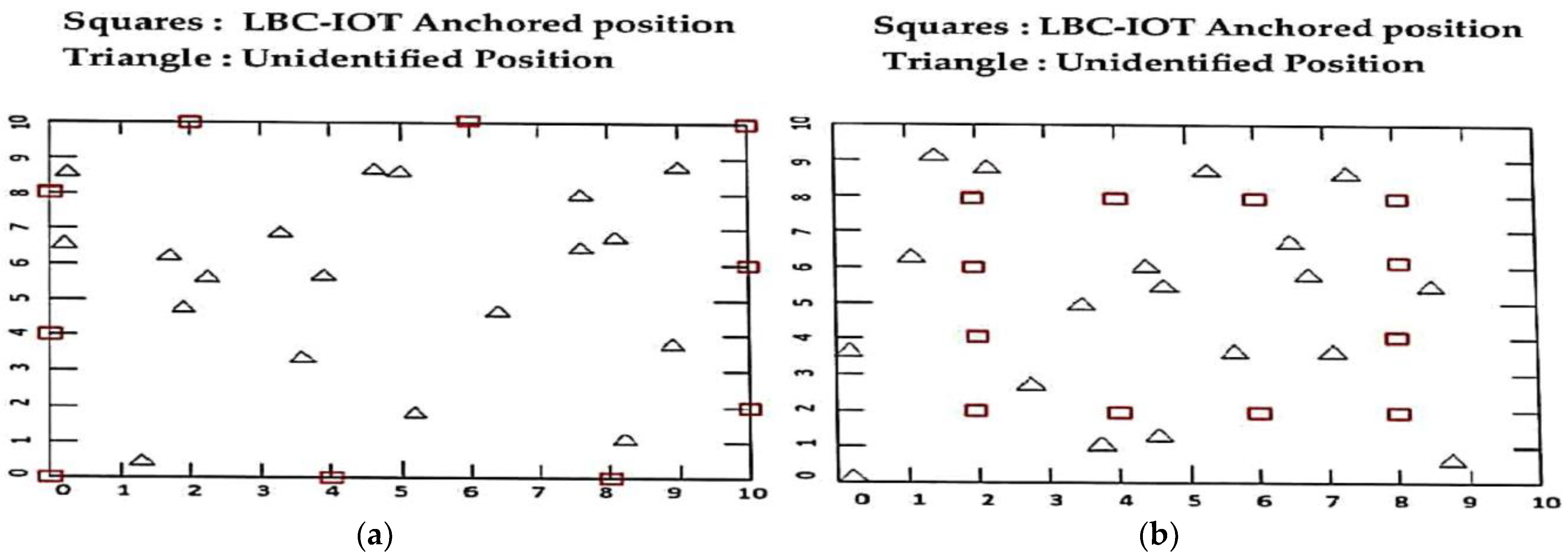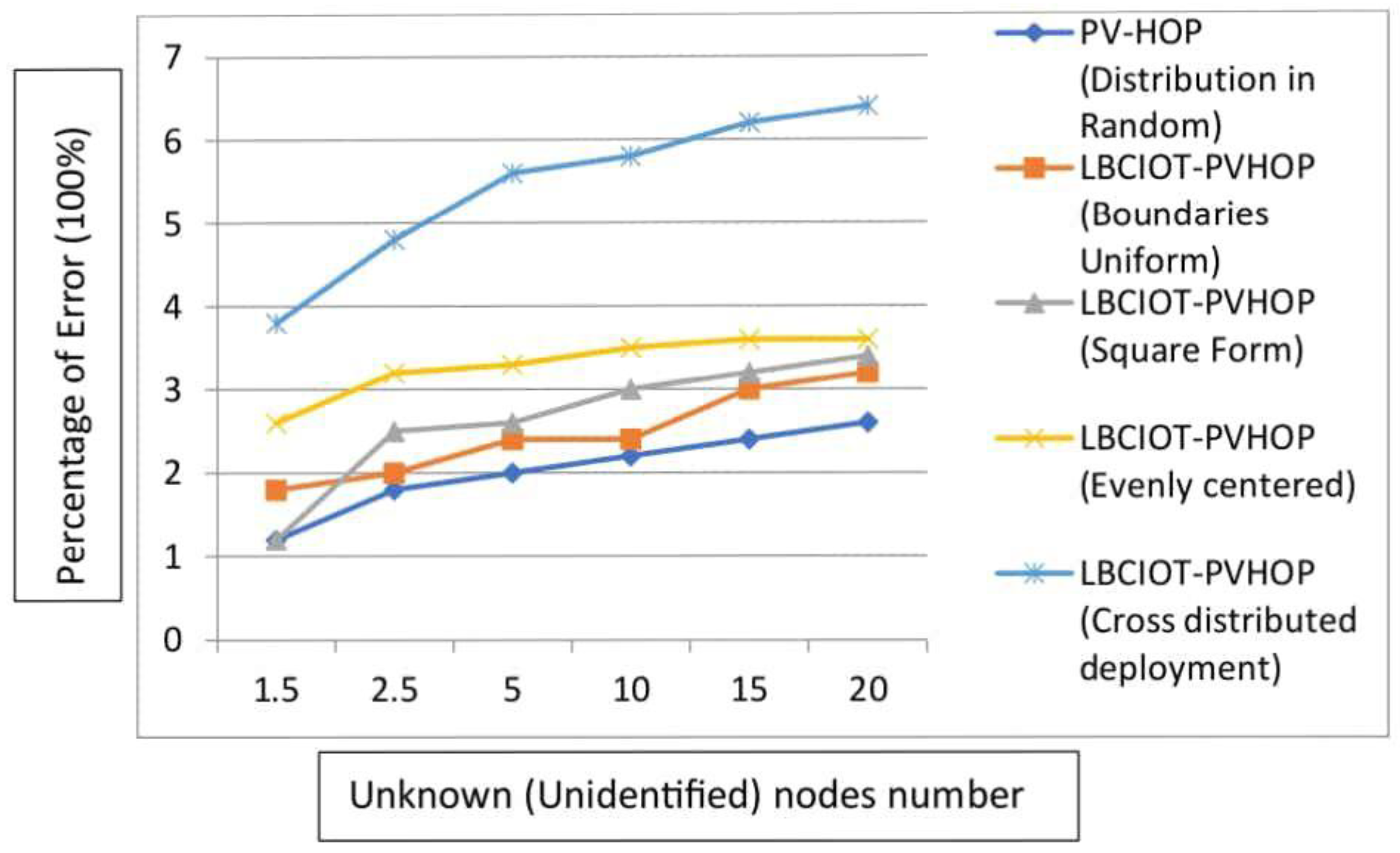Investigation of Incorporation of Internet of Things with Wireless Sensor Networks Based on Path Vector Hop Count and Limited Bandwidth Channel IoT Mechanism †
Abstract
1. Introduction
1.1. Benefits of WSN Node Positioning Centered on LBC-IoT Access
- IoT-LBC is a public utility network that is perfect for a variety of IoT-related applications because of its high signal propagation and low power consumption.
- The LBC-IoT main station locating capabilities may be used. The main station signal allows the network nodes of the IoT-LBC network to precisely determine their position. GPS signals are needed to improve base station placement accuracy in IoT-LBC, as 30 m precision is currently not sufficient.
- The IoT-LBC network’s backend processing capacity may be utilized. The first computation process may be carried out via the backend, but the calculation technique is more complicated. It involves finding a large number of unknown nodes and being prepared to send the measurements and the results of the calculations via a 4G/LTE-centered IoT-LBC network.
1.2. WSN Node Location Techniques and Algorithms
- Ranging-based positioning strategies involve measuring angular data and straight-line lengths between nodes, followed by calculating undetermined node coordinates using trilateral and triangulation methods of positioning [3].
- The non-ranging technique of positioning does not rely on node measurement of distance and may calculate undetermined node coordinates due to the network connection. The center-of-mass technique, the distance vector calculation procedure HOP-PV, and other approaches are widely used [4].
2. Materials and Methods
2.1. PV-HOP Algorithm for Node Location
- The first stage is to calculate the minimum quantity of bars that separate each anchor point from the unknown node point.
- The second stage is to determine the distance that lies between each anchored node and the location node.
- The location marker of the other anchored nodes recorded in the database, along with the total number of hops, may be used to compute each anchored node using a mean hop separation value of 1 [7]. The expression for the mean hop separation among all anchor nodes is given by Equation (1):
2.2. Positioning Technique for Shifting Anchored Point Multi-Position Change
2.2.1. LBC-IoT Mobile Access-Based Wireless Sensor Network
2.2.2. Optimization Technique for LBCIOT-PVHOP
3. Results and Discussion
3.1. Simulation Results
3.2. Effect of Quantity of Unexplored Nodes on Results
3.3. Impact of Allocation Rules of Anchored Position on Outcomes
3.4. Evaluation Analysis
4. Conclusions
Author Contributions
Funding
Institutional Review Board Statement
Informed Consent Statement
Data Availability Statement
Conflicts of Interest
References
- Liu, X. Application of Internet of things technology in facility agriculture in the context of smart agriculture development. Wirel. Interconnect. Technol. 2022, 19, 70–71. [Google Scholar]
- Huang, Y. Data confidentiality transmission method of wireless communication under Internet of Things technology. Inf. Comput. (Theory Ed.) 2022, 34, 198–200. [Google Scholar]
- Guo, K.; Dong, M.; Jiang, C. Application of internet of things technology for wireless temperature measurement of 220kV isolation knife gate in power plants. China New Technol. New Prod. 2021, 22, 85–87. [Google Scholar] [CrossRef]
- Sun, J.; Zhao, J. Sound surface wave wireless tag receiving method based on IOT technology. Electroacoust. Technol. 2022, 46, 106–108. [Google Scholar] [CrossRef]
- Haseeb, K.; Ud Din, I.; Almogren, A.; Islam, N. An energy efficient and secure IoT-based WSN framework: An application to smart agriculture. Sensors 2020, 20, 2081. [Google Scholar] [CrossRef] [PubMed]
- Qiao, R. Research and Design of Wireless Water Leakage Monitoring System Based on the Internet of Things Technology. Ph.D. Thesis, North Central University, Minneapolis, MN, USA, 2021. [Google Scholar]
- Chen, J. Analysis of Internet of things technology based on wireless communication technology. Inf. Comput. (Theory Ed.) 2020, 32, 172–173. [Google Scholar]
- Cheng, J.; Lv, X.; Hu, L. Hardware part design of wireless spectrum monitoring system based on Internet of Things technology. Sci. Technol. Innov. 2021, 13, 86–87. [Google Scholar]
- Xi Huang, Science and Technology. Exploring the application trends of wireless sensor network technology in the Internet of Things. China-Arab. Sci. Technol. Forum 2022, 8, 150–153, (In English and Chinese). [Google Scholar]
- Khera, S.; Mehla, N.; Kaur, N. Applications and challenges in wireless sensor networks. Int. J. Adv. Res. Comput. Commun. Eng 2016, 5, 448–451. [Google Scholar]
- Sujanthi, S.; Nithya Kalyani, S. SecDL: QoS-aware secure deep learning approach for dynamic cluster based routing in WSN assisted IoT. Wirel. Pers. Commun. 2020, 114, 2135–2169. [Google Scholar] [CrossRef]
- Wang, M. Analysis of the use of wireless sensor network in environmental monitoring system under Internet of Things technology. Commun. Power Technol. 2021, 38, 8385+88. [Google Scholar] [CrossRef]
- Yue, D. Research on key technologies of wireless sensor networks for the Internet of Things. Software 2022, 43, 172–175. [Google Scholar]
- Cao, L.; Wang, Z.; Yue, Y. Analysis and prospect of the applications of wireless sensor networks in ubiquitous power internet of things. Comput. Intell. Neurosci. 2022, 9004942. [Google Scholar] [CrossRef] [PubMed]
- Yaqoob, I.; Ahmed, E.; Hashem, I.A.T. Internet of things architecture: Recent advances, taxonomy, requirements, and open Challenges. IEEE Wirel. Commun. 2017, 24, 10–16. [Google Scholar] [CrossRef]
- Nourildean, S.W.; Hassib, M.D.; Mohammed, Y.A. Internet of things based wireless sensor network: A review. Indones. J. Electr. Eng. Comput. Sci. 2022, 27, 246–261. [Google Scholar] [CrossRef]




| Anchored Point Displacement Count | Error Rate (Average) % |
|---|---|
| 2 | 41.3 |
| 4 | 38.75 |
| 6 | 36.83 |
| 8 | 34.6 |
| 10 | 33.05 |
| 11 | 32.79 |
Disclaimer/Publisher’s Note: The statements, opinions and data contained in all publications are solely those of the individual author(s) and contributor(s) and not of MDPI and/or the editor(s). MDPI and/or the editor(s) disclaim responsibility for any injury to people or property resulting from any ideas, methods, instructions or products referred to in the content. |
© 2024 by the authors. Licensee MDPI, Basel, Switzerland. This article is an open access article distributed under the terms and conditions of the Creative Commons Attribution (CC BY) license (https://creativecommons.org/licenses/by/4.0/).
Share and Cite
Ramaiah, P.; Sinnasamy, S.S.; Selvaraj, V.; Ramasamy, R.; Anthonisamy, A.; Kuppusamy, S. Investigation of Incorporation of Internet of Things with Wireless Sensor Networks Based on Path Vector Hop Count and Limited Bandwidth Channel IoT Mechanism. Eng. Proc. 2024, 82, 113. https://doi.org/10.3390/ecsa-11-20372
Ramaiah P, Sinnasamy SS, Selvaraj V, Ramasamy R, Anthonisamy A, Kuppusamy S. Investigation of Incorporation of Internet of Things with Wireless Sensor Networks Based on Path Vector Hop Count and Limited Bandwidth Channel IoT Mechanism. Engineering Proceedings. 2024; 82(1):113. https://doi.org/10.3390/ecsa-11-20372
Chicago/Turabian StyleRamaiah, Purushothaman, Sathya Selvaraj Sinnasamy, Vairaprakash Selvaraj, Rajkumar Ramasamy, Arun Anthonisamy, and Sangeetha Kuppusamy. 2024. "Investigation of Incorporation of Internet of Things with Wireless Sensor Networks Based on Path Vector Hop Count and Limited Bandwidth Channel IoT Mechanism" Engineering Proceedings 82, no. 1: 113. https://doi.org/10.3390/ecsa-11-20372
APA StyleRamaiah, P., Sinnasamy, S. S., Selvaraj, V., Ramasamy, R., Anthonisamy, A., & Kuppusamy, S. (2024). Investigation of Incorporation of Internet of Things with Wireless Sensor Networks Based on Path Vector Hop Count and Limited Bandwidth Channel IoT Mechanism. Engineering Proceedings, 82(1), 113. https://doi.org/10.3390/ecsa-11-20372






